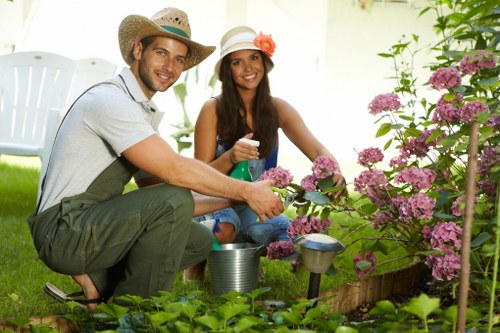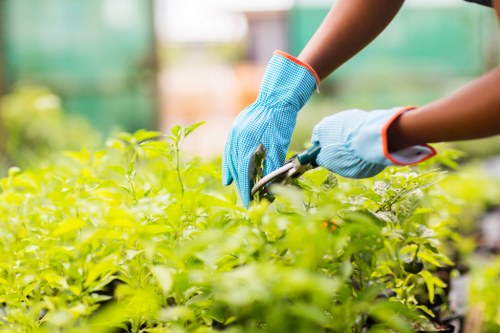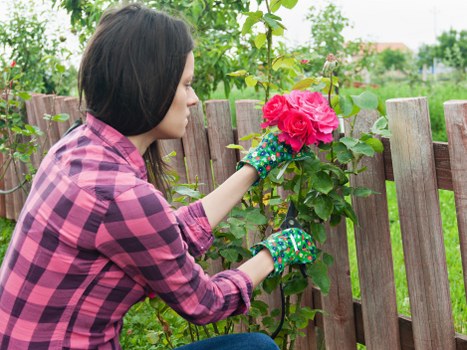Comprehensive Guide to Garden Fence Installation in Gardener Services
Why Choose Garden Fence Installation?

Installing a garden fence is a pivotal step in enhancing the beauty and functionality of your outdoor space. A well-chosen fence not only defines the boundaries of your garden but also adds aesthetic value, security, and privacy.
Garden fences come in various styles, materials, and heights, allowing homeowners to customize according to their specific needs and preferences. Whether you’re looking to keep pets safe, create a secluded sanctuary, or simply add a decorative element, garden fence installation plays a crucial role.
Moreover, a sturdy fence can act as a deterrent for unwanted intruders, providing an additional layer of security to your property. Investing in professional garden fence installation ensures that the structure is durable, well-maintained, and compliant with local regulations.
Types of Garden Fences

Selecting the right type of fence is essential for achieving the desired look and functionality in your garden. Here are some popular options:
- Wooden Fences: Classic and versatile, wooden fences offer a natural appearance and can be customized with various stains and paints.
- Vinyl Fences: Durable and low-maintenance, vinyl fences resist weathering and are available in a range of colors and styles.
- Metal Fences: Featuring materials like aluminum or wrought iron, metal fences provide robust security while adding an elegant touch.
- Composite Fences: Combining wood fibers and plastic, composite fences offer the aesthetic of wood with enhanced durability.
- Chain-Link Fences: An affordable option, chain-link fences are practical for defining boundaries without obstructing views.
Each type of fence has its own set of benefits, and the choice largely depends on your garden’s specific requirements and your personal style preferences.
Steps to Successful Garden Fence Installation

Proper installation is key to ensuring that your garden fence stands the test of time. Here are the fundamental steps involved:
- Planning and Design: Assess your garden layout, determine the fence’s purpose, and choose a suitable style and material.
- Permitting and Regulations: Check local building codes and obtain necessary permits to avoid future complications.
- Measuring and Marking: Accurately measure the area where the fence will be installed and mark the fence line.
- Foundation Preparation: Dig post holes at appropriate intervals and ensure they are deep enough to provide stability.
- Installing Posts: Place the fence posts in the holes, ensuring they are plumb and spaced correctly before setting them with concrete.
- Attaching Fence Panels or Rails: Once the posts are secure, attach the horizontal rails or fence panels.
- Finishing Touches: Add gates, decorative elements, and apply any finishes or treatments to protect the fence.
Following these steps meticulously ensures a robust and aesthetically pleasing fence that meets your garden’s needs.
Choosing the Right Materials

Material selection significantly impacts the durability, maintenance, and appearance of your garden fence. Here are considerations for popular materials:
- Wood: Offers versatility and warmth, but requires regular maintenance to prevent rot and weather damage.
- Vinyl: Resistant to moisture and pests, vinyl is ideal for low-maintenance applications but can be less sturdy than other materials.
- Metal: Provides excellent security and longevity, though it may require treatments to prevent rust.
- Composite: Combines the benefits of wood and plastic, offering durability with a natural look.
- Stone or Brick: Extremely durable and aesthetically pleasing, but they are permanent and require professional installation.
Selecting the appropriate material ensures that your fence aligns with your garden’s aesthetic and functional requirements while also fitting within your budget.
Professional vs. DIY Installation

Deciding between professional installation and a do-it-yourself approach depends on several factors:
- Expertise: Professionals bring experience and expertise, ensuring a high-quality fence installation.
- Time: DIY projects can be time-consuming, especially for larger or more complex installations.
- Tools and Equipment: Professional installers have access to specialized tools and equipment that may not be feasible for a homeowner to procure.
- Cost: While DIY can save on labor costs, potential mistakes may lead to higher expenses in the long run.
- Permitting and Regulations: Professionals are familiar with local codes and can handle the permitting process efficiently.
For those seeking a seamless and stress-free installation, hiring professional gardener services is often the preferred choice.
Maintenance Tips for Longevity

To ensure your garden fence remains in top condition, regular maintenance is essential. Here are some tips:
- Regular Cleaning: Remove dirt, debris, and mildew by cleaning your fence periodically with appropriate cleaning agents.
- Inspection: Check for signs of damage, such as loose boards, rust spots, or rot, and address issues promptly.
- Painting or Staining: Apply fresh coats of paint or stain to protect wood fences from weathering and to enhance their appearance.
- Repairing Damage: Replace broken or damaged sections to maintain the fence’s structural integrity.
- Reinforcing Structures: Tighten screws, nails, and other fasteners to keep the fence sturdy.
Consistent maintenance not only prolongs the lifespan of your fence but also keeps your garden looking pristine.
Enhancing Your Garden with Decorative Elements
Adding decorative elements can elevate the look of your garden fence and complement your overall garden design. Consider the following enhancements:
- Plants and Vines: Climbing plants like ivy or roses can add greenery and soften the fence’s appearance.
- Lighting: Installing solar or LED lights can illuminate your fence, adding both safety and ambiance during the evening.
- Ornamental Panels: Incorporate decorative panels or latticework to create intricate patterns and visual interest.
- Color Accents: Use vibrant colors or contrasts to highlight specific sections or create a focal point.
- Built-in Planters: Integrate planters into your fence design to display flowers or herbs, enhancing the garden’s beauty.
These decorative additions not only enhance the aesthetic appeal but also personalize your garden space, making it a unique reflection of your style.
Cost Factors in Garden Fence Installation
Understanding the cost factors involved in garden fence installation helps in budgeting and making informed decisions. Key cost considerations include:
- Material: The choice of material significantly affects the overall cost, with options ranging from affordable vinyl to high-end metal or stone.
- Size and Length: The total length and height of the fence determine the amount of materials required and the labor involved.
- Terrain: Uneven or rocky terrain can increase installation complexity and costs.
- Design Complexity: Intricate designs or custom features may require more time and specialized skills, impacting the price.
- Labor: Professional installation fees vary based on the contractor’s expertise and the project’s scope.
- Permits and Fees: Obtaining necessary permits may involve additional costs depending on local regulations.
By considering these factors, homeowners can better estimate the investment required for their garden fence project.
Environmental Considerations
When installing a garden fence, it’s important to consider the environmental impact. Sustainable practices not only benefit the planet but can also enhance your garden’s health and beauty:
- Eco-friendly Materials: Choose materials that are renewable, recyclable, or have a low environmental footprint, such as bamboo or reclaimed wood.
- Native Plants: Incorporate native plants and vines that require less water and are more resistant to local pests and diseases.
- Minimizing Waste: Plan your project to reduce material waste and consider recycling or repurposing excess materials.
- Energy-efficient Lighting: Use solar-powered lights to reduce energy consumption and lower your carbon footprint.
- Water Conservation: Install rain barrels or other water-saving systems to maintain your garden’s hydration without overusing water resources.
Implementing these environmentally friendly practices contributes to a sustainable garden and promotes ecological balance.
Common Challenges and Solutions
Installing a garden fence can present various challenges. Being prepared with solutions ensures a smooth project:
- Uneven Ground: Level the ground or use adjustable fence posts to accommodate terrain irregularities.
- Poor Soil Conditions: Enhance soil stability by adding gravel or other stabilizing materials around fence posts.
- Access to Utilities: Locate and avoid utility lines before digging to prevent disruptions and ensure safety.
- Weather Conditions: Plan installations during favorable weather to avoid delays and complications caused by rain or extreme temperatures.
- Permitting Delays: Apply for permits well in advance and ensure all documentation is complete to prevent project hold-ups.
Addressing these challenges proactively helps in maintaining the project timeline and achieving the desired outcome.
Benefits of Professional Gardener Services
Hiring professional gardener services for your garden fence installation offers numerous advantages:
- Expertise and Experience: Professionals bring specialized knowledge and years of experience, ensuring high-quality workmanship.
- Time Efficiency: Professional teams can complete the installation promptly, minimizing disruption to your daily life.
- Quality Materials: Access to premium materials and tools guarantees a durable and aesthetically pleasing fence.
- Customization: Professionals can tailor the fence design to match your garden’s unique requirements and your personal style.
- Compliance: Ensuring that the installation adheres to local building codes and regulations avoids potential legal issues.
- Warranty and Support: Many professional services offer warranties and ongoing support, providing peace of mind for your investment.
Choosing professional gardener services for your fence installation ensures a seamless and satisfactory experience from start to finish.
Enhancing Security with Garden Fences
A garden fence plays a significant role in enhancing the security of your property. Here’s how:
- Deterrence: A solid and well-maintained fence discourages potential intruders from attempting to breach your property.
- Visibility: Depending on the fence type, visibility can be maintained or restricted to prevent outsiders from observing your garden activities.
- Containment: Ensures that pets and children remain safely within the designated area, preventing accidents and escapes.
- Privacy: Blocks prying eyes, allowing you to enjoy your garden in peace without concerns about neighbors or passersby.
- Boundary Definition: Clearly marks your property lines, reducing disputes with neighbors over land ownership.
By addressing these security aspects, a garden fence enhances the overall safety and tranquility of your home environment.
Eco-Friendly Fence Installation Practices
Adopting eco-friendly practices during fence installation contributes to environmental sustainability:
- Sustainable Sourcing: Use materials sourced from sustainable forests or recycled products to minimize environmental impact.
- Energy-efficient Installation: Utilize techniques that reduce energy consumption during the installation process.
- Minimizing Chemical Use: Opt for non-toxic paints, stains, and sealants to protect both the environment and your garden plants.
- Water Management: Implement proper drainage systems to manage rainwater runoff and prevent soil erosion.
- Recycling and Upcycling: Reuse existing materials where possible and recycle any waste generated during installation.
These practices not only protect the environment but also contribute to a healthier and more sustainable garden.
Integrating Technology in Fence Installation
Modern technology offers innovative solutions for garden fence installation, enhancing both functionality and aesthetics:
- Smart Fencing: Incorporate features like automated gates, security cameras, and motion sensors to boost security and convenience.
- Solar Lighting: Use solar-powered lights to illuminate your fence, reducing energy costs and environmental impact.
- Automated Gates: Enhance accessibility with gates that open and close automatically, offering ease of use and increased security.
- Integrated Irrigation: Design fences that incorporate irrigation systems for seamless water distribution to garden plants.
- Virtual Design Tools: Utilize software to visualize fence designs and make informed decisions before installation.
Embracing technological advancements can significantly improve the functionality and appeal of your garden fence, providing a modern touch to your outdoor space.
Final Thoughts on Garden Fence Installation
Garden fence installation is a vital investment that enhances the beauty, security, and functionality of your outdoor space. By carefully selecting the right materials, styles, and professional services, you can achieve a fence that not only meets your practical needs but also complements your garden’s aesthetic.
Regular maintenance and consideration of environmental factors ensure the longevity and sustainability of your fence, allowing you to enjoy a beautiful and secure garden for years to come.
Contact us today to discuss your garden fence installation needs and transform your outdoor space into a stunning and secure haven.